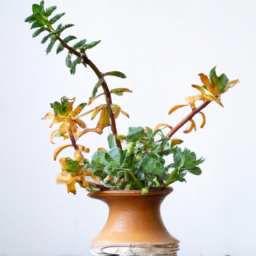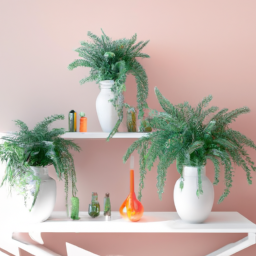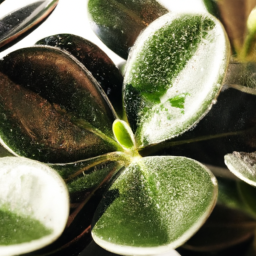
Have you ever wondered if there is a natural way to improve your well-being and create a soothing atmosphere in your home? Look no further than healing houseplants, the key to harnessing nature’s remedies. These incredible plants not only add a touch of greenery to your living space but also possess the power to heal and rejuvenate. Whether you are a seasoned plant enthusiast or a beginner looking to explore the world of indoor gardening, this blog post will guide you through the benefits of healing houseplants and how to incorporate them into your daily life. So, let’s dive in and discover the wonders of these botanical healers!
The Benefits of Healing Houseplants: Exploring Nature’s Remedies for Health and Wellness
Welcome to the world of healing houseplants, where nature’s remedies can work wonders for your health and wellness. In this article, we will delve into the incredible benefits of having houseplants in your home, exploring how they can improve the air quality, boost your mood, and even promote faster healing. So, let’s embark on this green journey together and discover the power of healing houseplants.
Improving Air Quality
One of the most significant benefits of healing houseplants is their ability to improve the air quality in your home. Plants have a natural ability to absorb carbon dioxide and release oxygen through photosynthesis, making them excellent air purifiers. However, certain houseplants go the extra mile by filtering out harmful toxins present in indoor air.
Plants like Aloe Vera, Spider Plant, and Peace Lily are known for their air-purifying properties. They can remove common indoor pollutants such as formaldehyde, benzene, and xylene, which are often found in cleaning products, paints, and synthetic materials. By having these plants in your home, you can create a healthier environment and reduce the risk of respiratory problems, allergies, and other health issues caused by poor air quality.
In addition to purifying the air, houseplants also increase humidity levels, which is beneficial, especially during dry seasons or in areas with low humidity. Proper humidity levels can help alleviate dry skin, sore throats, and respiratory discomfort, ensuring your overall well-being.
Mood Enhancement and Stress Reduction
Have you ever noticed how spending time in nature instantly boosts your mood and reduces stress? Well, healing houseplants can bring a piece of that natural tranquility into your home. Studies have shown that being surrounded by plants can have a positive impact on mental health, promoting relaxation and reducing anxiety.
The presence of greenery indoors has been linked to increased feelings of calmness and improved focus. Houseplants can help create a soothing atmosphere, making your living space a sanctuary where you can unwind after a long day. Their vibrant colors and textures can also uplift your spirits, adding a touch of beauty and serenity to your surroundings.
Incorporating houseplants into your workspace can be particularly beneficial. They can help reduce stress levels, increase productivity, and improve air quality, all of which contribute to a healthier and more enjoyable work environment.
Accelerating Healing and Recovery
Believe it or not, healing houseplants can even aid in the recovery process when you’re feeling under the weather. Numerous studies have shown that patients in hospital rooms with plants tend to experience faster healing and require less pain medication compared to those without any greenery around them.
Plants have a calming effect on patients, reducing stress and anxiety, which can be crucial for a speedy recovery. They also help create a more positive and nurturing environment, which positively impacts the patient’s overall well-being and outlook.
Furthermore, certain houseplants, such as Lavender and Chamomile, have natural soothing properties that can aid in relaxation and sleep. These plants release aromatic compounds that promote better sleep quality, making them a perfect addition to your bedroom, especially if you struggle with insomnia or restlessness.
So, whether you’re looking to improve your indoor air quality, enhance your mood, or accelerate healing and recovery, healing houseplants offer a natural and effective solution. Incorporating these green companions into your home can bring numerous benefits to your health and wellness, making your living space a true sanctuary of nature’s remedies.

Top Healing Houseplants: Discovering the Best Plants for Natural Remedies and Stress Relief
Welcome to the world of healing houseplants! In this guide, we will explore the top plants that not only bring beauty to your home but also offer natural remedies and stress relief. These houseplants have been used for centuries due to their therapeutic properties, and now it’s time to harness nature’s remedies for your well-being.
The Power of Houseplants
Houseplants are not just pretty decorations; they are living organisms that can positively impact your physical and mental health. Research has shown that having plants indoors can purify the air, increase humidity, and reduce stress levels. They also provide a sense of calm and tranquility, making them perfect companions for those seeking natural remedies and stress relief.
When it comes to healing houseplants, there are a few key factors to consider. Firstly, choose plants that are easy to care for and can thrive indoors. This ensures that you can enjoy their benefits without the added stress of complicated maintenance. Secondly, focus on plants with specific healing properties, such as air purification, relaxation, or boosting mood. Let’s dive into some of the top healing houseplants:
Aloe Vera
Aloe Vera is a popular healing houseplant known for its soothing properties. The gel inside its leaves can be used topically to treat burns, cuts, and skin irritations. It also acts as a natural moisturizer, promoting healthy skin. Aloe Vera is easy to care for and thrives in bright, indirect light. Make sure to allow the soil to dry out between waterings, as overwatering can lead to root rot.
Snake Plant
The Snake Plant, also known as Mother-in-Law’s Tongue, is a low-maintenance houseplant that is perfect for beginners. It is well-known for its air-purifying abilities, as it can remove toxins like formaldehyde and benzene from the air. Additionally, the Snake Plant releases oxygen at night, making it an excellent choice for bedrooms. It prefers indirect light and only needs to be watered sparingly.
Lavender
Lavender is a fragrant herb that is widely recognized for its calming and relaxing effects. Its scent can help reduce anxiety and promote better sleep. Growing lavender indoors requires bright light and well-draining soil. It’s important to let the soil dry out between waterings to prevent root rot. You can also harvest the flowers and make your own lavender oil for aromatherapy purposes.
Peace Lily
The Peace Lily is a beautiful houseplant that not only adds elegance to any space but also helps purify the air. It can remove toxins like formaldehyde, benzene, and carbon monoxide. The Peace Lily thrives in low light conditions and prefers to be kept slightly moist. Be cautious not to overwater, as it can lead to root rot. The plant will let you know when it needs water by drooping its leaves, but it quickly recovers once watered.
Spider Plant
The Spider Plant is an excellent choice for those seeking natural remedies and stress relief. It is known for its air-purifying properties and can remove toxins like formaldehyde and xylene from the air. Spider Plants are extremely resilient and can tolerate a wide range of conditions. They prefer bright, indirect light and should be watered thoroughly but allowed to dry out between waterings.
These are just a few examples of the top healing houseplants available. Each plant offers unique benefits, so feel free to explore and experiment with different varieties. Remember to choose plants that suit your lifestyle and preferences, and enjoy the therapeutic effects they bring to your home. Harnessing nature’s remedies through healing houseplants is a wonderful way to enhance your well-being and create a peaceful environment.

How to Create a Healing Houseplant Garden: Tips and Tricks for Harnessing Nature’s Remedies in Your Home
The Power of Healing Houseplants
Houseplants not only add beauty and freshness to our homes but also have the incredible ability to heal and improve our well-being. Harnessing nature’s remedies through a healing houseplant garden can provide numerous health benefits, both physical and mental. From purifying the air we breathe to reducing stress and boosting our mood, these green companions are truly magical. In this guide, we will explore the steps to create your own healing houseplant garden and unleash the power of nature’s remedies in your home.
Step 1: Choosing the Right Houseplants
The first step in creating a healing houseplant garden is selecting the right plants that possess medicinal properties. There are various types of houseplants known for their healing abilities, such as aloe vera, lavender, snake plant, and peace lily, to name a few. Consider the specific health benefits you are looking for and choose plants accordingly. For instance, aloe vera is excellent for treating minor burns and skin irritations, while lavender promotes relaxation and better sleep.
When selecting houseplants, also consider their care requirements. Different plants have different needs in terms of light, water, and temperature. Ensure that the plants you choose are suitable for the conditions in your home. This will help them thrive and provide optimal healing benefits.
Once you have chosen your healing houseplants, it’s time to move on to the next step.
Step 2: Creating the Ideal Environment
Creating the ideal environment for your healing houseplant garden is crucial for their growth and effectiveness. Here are some tips to ensure your plants thrive:
Light: Most houseplants require bright, indirect light. Find the right spot in your home where they can receive the required amount of light. South-facing windows are usually a good choice, but be mindful of direct sunlight, as it can damage certain plants.
Water: Proper watering is essential for the health of your houseplants. Each plant has different water requirements, so make sure to research and understand the needs of each individual plant. Avoid overwatering, as it can lead to root rot, and underwatering, which can cause wilting and stunted growth.
Humidity: Many healing houseplants thrive in humid environments. Increase humidity levels by misting the leaves with water or placing a tray of water near the plants. You can also group plants together to create a microclimate of higher humidity.
Temperature: Most houseplants prefer temperatures between 60-75°F (15-24°C). Avoid placing them near drafts or in extreme temperature conditions.
By providing the right environment, you are setting the stage for your healing houseplant garden to flourish.
Step 3: Caring for Your Healing Houseplants
Proper care is essential for the well-being of your healing houseplants. Here are some general guidelines to follow:
Watering: As mentioned earlier, each plant has different water requirements. Check the soil moisture regularly, and water accordingly. It’s better to underwater than overwater, as most houseplants are susceptible to root rot.
Fertilizing: Houseplants benefit from regular fertilization, especially during their active growing season. Choose a balanced, water-soluble fertilizer and follow the package instructions for application.
Pruning: Regular pruning helps maintain the shape and health of your houseplants. Remove any dead or yellowing leaves, and trim back overgrown branches to encourage new growth.
Pest Control: Keep an eye out for common houseplant pests such as aphids, spider mites, and mealybugs. If you notice any infestations, treat them promptly with natural or organic pest control methods.
Remember to research the specific care requirements of each plant in your healing houseplant garden and provide the necessary attention and care they need.
Step 4: Maximizing the Healing Benefits
Now that your healing houseplant garden is thriving, it’s time to maximize the benefits they offer:
Air Purification: Houseplants are excellent natural air purifiers. They absorb harmful toxins and release oxygen, improving the air quality in your home. To enhance their air-purifying capabilities, consider placing multiple plants throughout your living spaces.
Stress Reduction: Spending time with your healing houseplants can help reduce stress and promote relaxation. Create a designated space in your home where you can unwind and connect with nature. Surround yourself with your plants, practice mindfulness, and enjoy the calming effects they provide.
Aromatherapy: Many healing houseplants, such as lavender and eucalyptus, emit soothing scents that can enhance your well-being. Consider using essential oils extracted from these plants for aromatherapy purposes. Diffuse the oils or mix them with carrier oils for massages to experience their healing properties.
Conclusion
Creating a healing houseplant garden is a wonderful way to harness nature’s remedies and improve your overall well-being. By carefully selecting the right plants, providing the ideal environment, and practicing proper care, you can unlock the full potential of these green healers. Embrace the power of healing houseplants and transform your home into a sanctuary of wellness and tranquility.
Key Takeaways of this article
Houseplants are not only a beautiful addition to our homes, but they can also provide us with numerous health benefits. These green companions have the power to heal us, both physically and mentally, by harnessing nature’s remedies. Research has shown that houseplants can purify the air we breathe, boost our mood, reduce stress levels, and even improve our concentration.
One of the most well-known benefits of houseplants is their ability to purify the air. Through the process of photosynthesis, plants absorb carbon dioxide and release oxygen, improving the air quality in our homes. Additionally, certain plants, such as the snake plant and peace lily, have been found to remove harmful toxins like formaldehyde and benzene from the air. This can be especially beneficial for those who suffer from allergies or asthma.
In addition to their air-purifying qualities, houseplants have a positive impact on our mental well-being. Studies have shown that being around plants can reduce stress levels and promote relaxation. The act of caring for plants can also provide a sense of purpose and fulfillment, boosting our mood and overall happiness. Furthermore, having plants in our living spaces has been linked to increased productivity and improved concentration, making them a valuable addition to home offices or study areas.
In conclusion, houseplants are more than just decorative elements in our homes. They can be powerful healers, providing us with cleaner air, reduced stress, and improved mental well-being. So, why not invite some greenery into your living space and let nature work its magic?
Check Out These FAQs:
Q1: What are healing houseplants?
A1: Healing houseplants refer to specific types of plants that have been known to possess therapeutic properties, promoting physical and mental well-being. These plants are believed to enhance air quality, reduce stress, improve mood, and even alleviate certain health conditions.
Q2: What are some examples of healing houseplants?
A2: There are several healing houseplants that you can consider for your home. Some popular examples include aloe vera, known for its soothing properties for burns and skin irritations, lavender, which can help with relaxation and sleep, and snake plants, which are known for their ability to purify the air.
Q3: How do healing houseplants harness nature’s remedies?
A3: Healing houseplants harness nature’s remedies through various mechanisms. They can release beneficial compounds into the air, such as essential oils, which can have a positive impact on our physical and mental health. Additionally, they can help purify the air by removing toxins and producing oxygen, creating a healthier indoor environment.
Q4: How do I care for healing houseplants?
A4: Caring for healing houseplants is relatively straightforward. Most of these plants require regular watering, but it’s important not to overwater them, as it can lead to root rot. They also need sufficient sunlight, so placing them near a window or in a well-lit area is ideal. Additionally, providing them with the right type of soil and occasional fertilization can help them thrive.
Q5: Can healing houseplants really improve my well-being?
A5: While healing houseplants are not a magical cure-all, numerous studies have shown that they can have a positive impact on our well-being. They can improve air quality, reduce stress levels, boost mood, and even enhance productivity. Incorporating healing houseplants into your living or working space can contribute to a healthier and more harmonious environment.
Dr. Olivia Green is a botanist with over two decades of experience in indoor plant cultivation. She holds a Ph.D. in Plant Biology and has dedicated her career to researching plant behavior in controlled environments. Dr. Green is passionate about helping plant enthusiasts master the art of indoor gardening through her extensive knowledge and practical insights.


